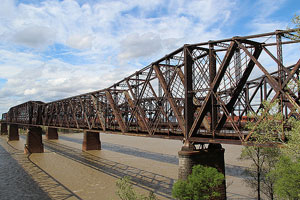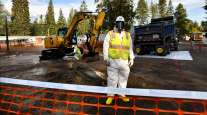124-Year-Old Frisco Bridge Getting Extensive Makeover by BNSF

BNSF Railway Co. is rebuilding virtually the entire western approach to the span, which, despite being 124 years old, still carries 90 million tons of rail freight annually and represents an important part of the company's, and nation's, transportation infrastructure. It's the largest bridge on the rail line's corridor from Kansas City, Missouri, and Birmingham, Alabama.
The three-year project got underway in January and entails replacing 50 spans and their piers on the viaduct between the river's edge at the Arkansas bank and the abutment nearly a half mile to the northwest, toward West Memphis. BNSF has drilled deep foundations for massive concrete columns that will support new piers and girders for the bridge.
 Google Maps
Google MapsAlthough no cost estimates for the work were available, the project is part of BNSF's systemwide "overall infrastructure improvement program," company spokesman Joseph Faust said. The 2016 budget for the program is $4.3 billion, he said.
The project is perhaps the most ambitious yet to rehabilitate a bridge constructed at a time when the Lower Mississippi represented an unconquered geographic barrier, when open-hearth steel was still a novelty and when Benjamin Harrison occupied the White House.
Its origins can be traced to George H. Nettleton, president of the old Kansas City, Fort Scott & Memphis Railway, who commissioned George S. Morrison to study the feasibility of a bridge over the Mississippi at Memphis. At the time, trains had to be ferried across the river a few cars at a time — a costly, time-consuming process.
Historic Frisco Bridge undergoing major rehab. via @memphisnews https://t.co/LlzIr9f80t — Thomas Charlier (@thomasrcharlier) June 11, 2016
The bridge cost $3 million at the time, or roughly $80 million in today's dollars. The central span of the structure, reaching 790 feet to allow for safe river navigation, was among the longest in the nation in the late 19th Century.
When it opened May 12, 1892, the bridge was the only one crossing the Mississippi south of St. Louis. Some 50,000 people turned out for an opening celebration featuring a test of 18 locomotives crossing "in solid train" to demonstrate the bridge's strength, according to newspaper accounts. The governors of Tennessee and Arkansas met midway on the span.
The Memphis Appeal-Avalanche, a predecessor to The Commercial Appeal, declared the span a "world wonder" and said its opening was an event that "was the most auspicious to the people of Memphis in the history of the city."
Considering the economic impact of the bridge, that statement wasn't too much of an exaggeration.
"It opened up crossing the Mississippi by means other than a ferry," said Mike Condren, a retired Christian Brothers University professor and self-described "train nut" who has created Web pages devoted to railroads.
"They could operate a much longer train and not have to stop, tear it apart and carry it across the river a few cars at a time, then reassemble it."
Once known as The Memphis Bridge, the span's name changed after the Frisco Lines purchased the railroad in 1903. In 1916, the completion of the adjacent Harahan Bridge added a second river crossing at Memphis.
Although the span was a technological wonder and "very well made from the beginning," some of the newer, larger steam locomotives of the early 20th Century were too heavy for it, Condren said. By 1926, a magazine article said Frisco was contemplating reinforcing the bridge.
Over the years, there have been numerous repairs and upgrades to the bridge — both by Frisco and BNSF, which absorbed the former rail company more than 30 years ago.
The current rehab project comes as a bicycle-pedestrian boardwalk is being installed on the Harahan in a project known as the Big River Crossing. Because the approach to the Harahan runs underneath the Frisco viaduct on the Arkansas side, work on the boardwalk will have to be coordinated with the BNSF project, officials say.




